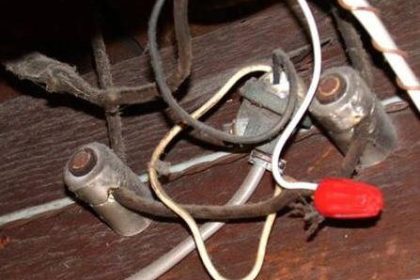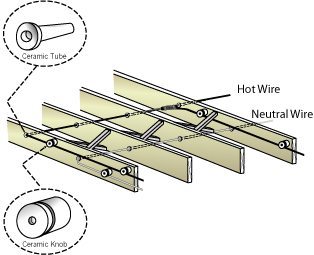Residential Wiring Errors – What’s lurking within your walls?

PART 1: Residential Wiring Problems Caused by Older or Mis-Wired Systems
As a former carpenter and electrician, I have seen and worked with a lot of building wiring, both residential and commercial. As an inspector I have seen many residential wiring errors and problems caused by older or improperly designed or installed electrical systems.
Let me start with a brief summary explanation of the common types of wiring materials.
Most residential and light commercial units have a 2 phase electrical service, so I will focus on that (many shops, manufacturing and heavier industrial applications can use 3-phase or more and have a higher amperage and voltage service than is ever seen in most residences and offices).
2-phase service enters the Meter Box (Service Entrance) from the transformer though three wires, 2 “hot” wires of 120 volts each that are 180O out of phase and a common, or neutral wire that completes the circuit to the transformer. This allows a building to access 120-volt power on each “hot” wire and combine them if 240 volts is needed. The service entrance box also has a grounding bus that is connected to a grounding rod (or building plumbing in older houses). From the service entrance the power runs through a bus and into individual circuit breakers, then through the individual circuit wiring to the outlets, lights, switches, etc.
I am going to describe the common types of wiring currently found in residential and light commercial buildings and the problems that can be associated with each type of wiring. Then I am going to outline some solutions to these residential wiring errors–some easy and some more complex.
I am also going to make recommendations if you are building new or remodeling and have the opportunity to choose a wiring system, both for safety and to reduce magnetic and electric field exposure that may be caused by building wiring.
Let’s start with Knob and Tube wiring. With Knob and Tube, the hot and neutral wires are separated and run though the joists and studs through ceramic tubes and turn corners around ceramic knobs, to insulate the wires from the building. This is the earliest form of residential wiring and is still found in many older homes. I have seen it often in some of the classic Victorian and Craftsman style homes in the San Francisco Bay Area.

Knob & Tube Wiring
Knob & Tube wiring was the standard until the 1960’s.
Although Knob and Tube works and is still in use it does pose several problems:
Knob and Tube wiring does not meet current electrical code, although existing Knob and Tube is “Grandfathered” in unmodified homes.
By definition all existing Knob and Tube is at least 50 years old. Most of the insulation is made from natural fibers, not plastic, and may be deteriorating. I have seen insulation on active Knob and Tube disintegrate at the slightest touch. This leaves the live conductors bare which is both an electrocution and fire hazard. Rodents have also been known to chew through the insulation and use it for nesting material.
The metal of the conductor is usually solid and can become brittle with age, leading to breakage of the wire, which can be both an electrocution and fire hazard.
The ceramic knobs and tubes are very durable but they can break and leave a wire exposed to chaffing.
Knob and Tube was installed when electrical demand was low and many houses had few electrical devices. It may not be able to handle the excess current demanded by modern homes, causing fuses to blow and excessive heating of the conductor which is a potential fire hazard.
Outlets connected to Knob and Tube are typically not “grounded”. In fact, knob and tube is an ungrounded system. Even if your outlets have three prongs, if they are connected to Knob and Tube, they are most likely NOT grounded.

Knob & Tube Wiring Buried in Insulation
Many older houses were not insulated and Knob and Tube was not designed to be buried with insulation, but I see it all the time. This insulation can hide breaks in the wire and insulation and could be a fire hazard.
Many older houses have had their wiring “upgraded”, but newer wiring is just spliced into the existing Knob and Tube. Sometimes newer wiring is added to new circuits, but the older knob and tube is left as is in the existing circuits.
Splices are supposed to be done inside a junction box and not left exposed.
The most important issue to many of my inspection clients, who are concerned with magnetic fields is the fact that that Knob and Tube wiring emits high and far reaching low frequency AC (Alternating Current) magnetic fields. The separation of the “hot” and “neutral” conductors by as much as 12-15 inches causes a significant increase in the magnetic field around the wiring. Although the health effects of high AC magnetic fields are in dispute, many people are concerned about them and prefer to create a low magnetic field environment in their homes and especially in their sleeping areas.
Knob and tube also does not shield against Electric Fields induced by the wiring.
So what to do about residential wiring errors?
If you have a home built before 1965 it is a good idea to have your wiring inspected. Has it been updated? With what type of wire? Was ALL the Knob and Tube removed, or was the modern wiring just spliced in?
Do you still have a fuse box? Or has your service been upgraded with circuit breakers? Upgrading to circuit breakers is safer and much more convenient especially when a circuit overloads and trips a breaker rather than blows a fuse.
I highly recommend that any and all Knob and Tube be removed and replaced with modern wiring. Many times modern wiring is installed but the legacy Knob and Tube is disconnected but left in place, to save a few bucks. It does take a little extra effort to remove the old Knob and Tube wiring. If the older wiring is not removed it can be confusing to a future electrician and some of it may still be active. I was told on a particular job that all the Knob and Tube had been disconnected but I found some of it to still be active and live, a definite fire and electrocution hazard. Fortunately, I was taught to assume all wires are live and I test any wire personally before working on ANY wiring.
Fully removing and replacing your old Knob and Tube can be difficult and expensive but is easier if you have an accessible attic and crawl space. I assure you the benefits are well worth it, and it should add to the value of your home, as well as adding to your electrical safety and capacity. The different types of wiring options and their pros and cons will be discussed next month in Part Two.



